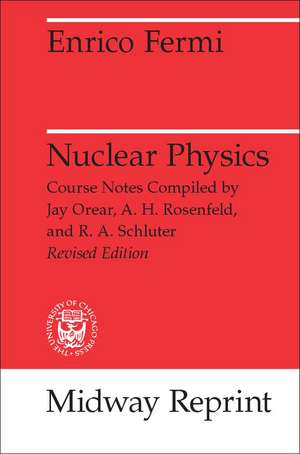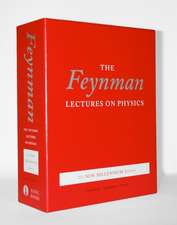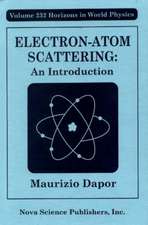Nuclear Physics: A Course Given by Enrico Fermi at the University of Chicago
Autor Enrico Fermien Limba Engleză Paperback – 31 iul 1974
This volume presents, with some amplification, the notes on the lectures on nuclear physics given by Enrico Fermi at the University of Chicago in 1949.
"The compilers of this publication may be warmly congratulated. . . . The scope of this course is amazing: within 240 pages it ranges from the general properties of atomic nuclei and nuclear forces to mesons and cosmic rays, and includes an account of fission and elementary pile theory. . . . The course addresses itself to experimenters rather than to specialists in nuclear theory, although the latter will also greatly profit from its study on account of the sound emphasis laid everywhere on the experimental approach to problems. . . . There is a copious supply of problems."—Proceedings of the Physical Society
"Only a relatively few students are privileged to attend Professor Fermi's brilliant lectures at the University of Chicago; it is therefore a distinct contribution to the followers of nuclear science that his lecture material has been systematically organized in a publication and made available to a much wider audience."—Nucelonics
"The compilers of this publication may be warmly congratulated. . . . The scope of this course is amazing: within 240 pages it ranges from the general properties of atomic nuclei and nuclear forces to mesons and cosmic rays, and includes an account of fission and elementary pile theory. . . . The course addresses itself to experimenters rather than to specialists in nuclear theory, although the latter will also greatly profit from its study on account of the sound emphasis laid everywhere on the experimental approach to problems. . . . There is a copious supply of problems."—Proceedings of the Physical Society
"Only a relatively few students are privileged to attend Professor Fermi's brilliant lectures at the University of Chicago; it is therefore a distinct contribution to the followers of nuclear science that his lecture material has been systematically organized in a publication and made available to a much wider audience."—Nucelonics
Preț: 345.86 lei
Nou
Puncte Express: 519
Preț estimativ în valută:
66.18€ • 69.42$ • 55.09£
66.18€ • 69.42$ • 55.09£
Carte tipărită la comandă
Livrare economică 01-15 aprilie
Preluare comenzi: 021 569.72.76
Specificații
ISBN-13: 9780226243658
ISBN-10: 0226243656
Pagini: 258
Dimensiuni: 152 x 229 x 18 mm
Greutate: 0.38 kg
Ediția:Revizuită
Editura: University of Chicago Press
Colecția University of Chicago Press
ISBN-10: 0226243656
Pagini: 258
Dimensiuni: 152 x 229 x 18 mm
Greutate: 0.38 kg
Ediția:Revizuită
Editura: University of Chicago Press
Colecția University of Chicago Press
Cuprins
Chapter 1. Properties of Nuclei
A. Isotope, Charts and Tables
B. Packing Fraction and Binding Energy
C. Liquid Drop Model
1. Semi-empirical mass formula
2. Isobaric behavior
3. β-emission
4. Periodic shell structure
D. Spin and Magnetic Dipole Moment
E. Electric Quadrupole Moment
F. Radioactivity and its Geological Aspects
G. Measurement and Biological Aspects of Radioactivity
Appendices
1. Magnetic Moment for Closed-shell-plus-one Nuclei
2. Electric Quadrupole Moment
3. Mass Correction for Neutron Excess Problems
Chapter 2. Interaction of Radiation with Matter
1. Energy Loss by Charged Particles
2. Bohr formula
3. Electrons
4. Other particles
5. Other absorbers
6. Range
7. Polarization Effects
8. Nature of equation for -dE/dx
9. Ionization of a gas
10. Radiation
B. Scattering
1. Classical calculation for single scattering
2. Multiple scattering
C. Passage of Electromagnetic Radiation through Matter
1. Photoelectric absorption
2. Compton scattering
3. Radiation loss by fast electrons
4. Pair formation
5. Cosmic ray showers
6. Summary
Appendices
1, 2, 3. Multiple scattering
4. Momentum and pair creation
References
Chapter 3. Alpha Emission
A. Rectangular Barrier
B. Barrier of Arbitrary Shape
C. Application of Barriers to α-decay
D. Virtual Level Theory of α-decay
E. α-ray Spectra
Appendix
Chapter 4. Beta-Decay
A. Introduction
B. Examples of β-processes
C. Energy diagrams
D. Theory of β-decay
E. Rate of Decay
F. Shape of Energy and Momentum Spectra
G. Experimental Verification
H. Selection Rules
J. Fτ Tables
K. Remarks on K-capture
L. Remarks on the Neutrino Hypothesis
M. Neutrinos and Anti-neutrinos
Chapter 5. Gamma-Decay
A. Spontaneous Emission
General emission formula
Electric dipole emission
Magnetic dipole emission
Half lives
B. Selection Rules
1. Angular Momentum
2. Parity
3. Improbability of nuclear dipole radiation
4. Summary
5. Dipole absorptionat high energies
C. Internal Conversion
1. Theory of internal conversion
2. Selection rules
3. Other processes
4. Experimental determination of conversion coeff.
D. Isomeric States
Problems
Chapter 6. Nuclear Forces
A. Introduction
1. Meson Theory
2. Saturation of nuclear forces
3. Exchange forces
B. The Deuteron
1. Non-central and spin-dependent forces
2. Ground state of the deuteron
C. Neutron-Proton Scattering
1. Method of partial waves
2. Low-energy solution for σ
3. Virtual state of the deuteron
4. Evidence for exchange forces
D. Proton-Proton Forces
1. Pauli principle complications
2. Spin functions
3. Coulomb scattering
E. Neutron-Neutron Forces
Chapter 7. Mesons
A. Experimental Properties
B. Theory
References for mason theory
Problems
Chapter 8. Nuclear Reactions
A. Notation
B. Cross Sections, General
C. Inverse Processes
D. Compound Nucleus
E. Example of an Unstable Nucleus (4Be8)
F. Resonances; Breit-Wigner Formula
G. Resonances; Data
H. Statistical Nuclear Gas Model
J. Fission
K. Orbit Model of the Nucleus
L. Capture of Slow Neutrons by Hydrogen
M. Photonuclear Reactions
N. Remarks on Very High Energy Phenomena
Chapter 9. Neutrons
A. Neutron Sources
1. Radioactive sources
2. Photo-sources
3. Artificial sources
B. Slowing Down of Neutrons
1. Inelastic
2. Elastic
3. Energy distribution of neutrons from a mono-
energetic source
4. Distance from a point source vs. energy
C. Diffusion Theory
1. Age Equation
2. Distribution of thermal neutrons
D. Scattering of Neutrons
1. Effect of chemical binding
2. Low energy scattering
3. Interference phenomena
4. Para- and ortho-hyrogen
5. Crystalline diffraction
6. Index of refraction
7. Scattering by microcrystals
8. Polarization of neutron beams
E. Theory of Chain Reactions
Chapter 10. Cosmic Rays
A. Primary Radiation
B. Secondary Radiation
1. Protons
2. Neutrons
3. Mesons
4. Electronic Component
C. Analysis into Hard and Soft Component
D. Motion in the Earth's Magnetic Field
1. Trajectories
2. Illustration: Equatorial Plane, Shadow Effect
3. Intensity: Liouville theorem
4. Charge of Primary Radiation
5. Latitude Effect
References
Notation
Physical Constants and Values
Index
A. Isotope, Charts and Tables
B. Packing Fraction and Binding Energy
C. Liquid Drop Model
1. Semi-empirical mass formula
2. Isobaric behavior
3. β-emission
4. Periodic shell structure
D. Spin and Magnetic Dipole Moment
E. Electric Quadrupole Moment
F. Radioactivity and its Geological Aspects
G. Measurement and Biological Aspects of Radioactivity
Appendices
1. Magnetic Moment for Closed-shell-plus-one Nuclei
2. Electric Quadrupole Moment
3. Mass Correction for Neutron Excess Problems
Chapter 2. Interaction of Radiation with Matter
1. Energy Loss by Charged Particles
2. Bohr formula
3. Electrons
4. Other particles
5. Other absorbers
6. Range
7. Polarization Effects
8. Nature of equation for -dE/dx
9. Ionization of a gas
10. Radiation
B. Scattering
1. Classical calculation for single scattering
2. Multiple scattering
C. Passage of Electromagnetic Radiation through Matter
1. Photoelectric absorption
2. Compton scattering
3. Radiation loss by fast electrons
4. Pair formation
5. Cosmic ray showers
6. Summary
Appendices
1, 2, 3. Multiple scattering
4. Momentum and pair creation
References
Chapter 3. Alpha Emission
A. Rectangular Barrier
B. Barrier of Arbitrary Shape
C. Application of Barriers to α-decay
D. Virtual Level Theory of α-decay
E. α-ray Spectra
Appendix
Chapter 4. Beta-Decay
A. Introduction
B. Examples of β-processes
C. Energy diagrams
D. Theory of β-decay
E. Rate of Decay
F. Shape of Energy and Momentum Spectra
G. Experimental Verification
H. Selection Rules
J. Fτ Tables
K. Remarks on K-capture
L. Remarks on the Neutrino Hypothesis
M. Neutrinos and Anti-neutrinos
Chapter 5. Gamma-Decay
A. Spontaneous Emission
General emission formula
Electric dipole emission
Magnetic dipole emission
Half lives
B. Selection Rules
1. Angular Momentum
2. Parity
3. Improbability of nuclear dipole radiation
4. Summary
5. Dipole absorptionat high energies
C. Internal Conversion
1. Theory of internal conversion
2. Selection rules
3. Other processes
4. Experimental determination of conversion coeff.
D. Isomeric States
Problems
Chapter 6. Nuclear Forces
A. Introduction
1. Meson Theory
2. Saturation of nuclear forces
3. Exchange forces
B. The Deuteron
1. Non-central and spin-dependent forces
2. Ground state of the deuteron
C. Neutron-Proton Scattering
1. Method of partial waves
2. Low-energy solution for σ
3. Virtual state of the deuteron
4. Evidence for exchange forces
D. Proton-Proton Forces
1. Pauli principle complications
2. Spin functions
3. Coulomb scattering
E. Neutron-Neutron Forces
Chapter 7. Mesons
A. Experimental Properties
B. Theory
References for mason theory
Problems
Chapter 8. Nuclear Reactions
A. Notation
B. Cross Sections, General
C. Inverse Processes
D. Compound Nucleus
E. Example of an Unstable Nucleus (4Be8)
F. Resonances; Breit-Wigner Formula
G. Resonances; Data
H. Statistical Nuclear Gas Model
J. Fission
K. Orbit Model of the Nucleus
L. Capture of Slow Neutrons by Hydrogen
M. Photonuclear Reactions
N. Remarks on Very High Energy Phenomena
Chapter 9. Neutrons
A. Neutron Sources
1. Radioactive sources
2. Photo-sources
3. Artificial sources
B. Slowing Down of Neutrons
1. Inelastic
2. Elastic
3. Energy distribution of neutrons from a mono-
energetic source
4. Distance from a point source vs. energy
C. Diffusion Theory
1. Age Equation
2. Distribution of thermal neutrons
D. Scattering of Neutrons
1. Effect of chemical binding
2. Low energy scattering
3. Interference phenomena
4. Para- and ortho-hyrogen
5. Crystalline diffraction
6. Index of refraction
7. Scattering by microcrystals
8. Polarization of neutron beams
E. Theory of Chain Reactions
Chapter 10. Cosmic Rays
A. Primary Radiation
B. Secondary Radiation
1. Protons
2. Neutrons
3. Mesons
4. Electronic Component
C. Analysis into Hard and Soft Component
D. Motion in the Earth's Magnetic Field
1. Trajectories
2. Illustration: Equatorial Plane, Shadow Effect
3. Intensity: Liouville theorem
4. Charge of Primary Radiation
5. Latitude Effect
References
Notation
Physical Constants and Values
Index















